Originally built in the year of Chunxi of South Song Dynasty (1174~1189) by a dismissed official Zhang Jun (张浚), Master of the Nets Garden was called Fisherman’s hermitage (鱼隐). In the year of Qianlong of Qing Dynasty (1765), another retired official called Song Zongyuan (宋宗元) restored the garden and renamed as Master of the Nets. About thirty years later, a wealthy merchant got the garden and expanded it to present scale. Fine pavilions and interesting rockeries were settled down. During the Republican period, renowned painter Zhang Daqian (张大千) and his brother have lived there for four years, and some priceless works were finished here.
With an area of nearly 5,334 square meters and less than 1/6 of the Humble Administrator’s Garden, it enjoys a compact but well-proportioned layout. Delicate buildings, classical landscape and thick culture make Master of the Nets Garden a representation of small classical gardens of the south of Yangtze River. Owning so much to cherish, Master of the Nets Garden is a typical Suzhou private garden recognized as the World Cultural Heritage with eight other gardens by UNESCO, a National AAAA Scenic Spot and a historical & cultural relic under state protection.
√ 2 Days Suzhou Classic Garden Tour
Master of the Nets Garden consists of three main sections: the residential area in the east, the main garden in the center and the inner garden in the west.
The residential area is built according to the sumptuary regulation strictly, with halls on north-south axis just as traditional Chinese palace, connected with the central garden separately. The elegant ornamentation of the front gate signifies the owner’s high status.
The main garden centers on a small pond surrounded by elaborately designed manmade landscape like verandas, pavilions, rockeries and walkways. Compared with the structure in the residential area, the architectures seem much freer and comfortable for viewing, reading, painting or sipping tea.
The inner garden is a charming courtyard grown with beautiful herbaceous peonies. There also stands most notable Peony Study (殿春簃), which enjoys a high prestige among the architects.
Though the size of Master of the Nets Garden is petty, the scale of the building is large and distinctive, and nothing appears cramped. Perfect design makes it recreate natural scenery in miniature successfully. In daytime, Master of the Nets Garden is a peaceful landscape painting giving you a visual treat.
Gateway with Brick Carving is the gate of Wanjuan Hall (万卷堂), the main hall of Master of the Nets Garden. Covering a history of over 300 years, it is still quaint and graceful. Featuring with remarkable brick carvings, the gateway is famed as the First Gateway in the South of Yangtze River. These carvings on the gateway are engraved by chisels and plane with various techniques. A horizon horizontal inscribed board inscribed with Zao Yao Gao Xiang is hanging above the gateway. Above the board are carvings of luxury weeds which represent longevity and auspiciousness. On the left side are opera figures of Congratulating on Guo Ziyi’s Birthday 《郭子仪拜寿》. Guo Ziyi was a general who had suppressed the insurgency, so he won great respect of his colleagues and his descendants. From the carvings, we can see grandfatherly Guo Ziyi and eight officials holding tributes or weapons. On the right side of the board are the opera figures of Emperor Wenwang’s visit to Virtuous and Talented Person 《周文王访贤》. In the history, Emperor Wenwang is good emperor in Zhou Dynasty. These carvings depict that he visited Jiang Ziya and entreated him to help to start a great cause. The carving of the first story means longevity and good fortune, and the second stands for integrity and ability.
Telling the historical story and showing the folk art, the Gateway with Brick Carvings enriches the cultural connotation of Master of the Nets Garden.
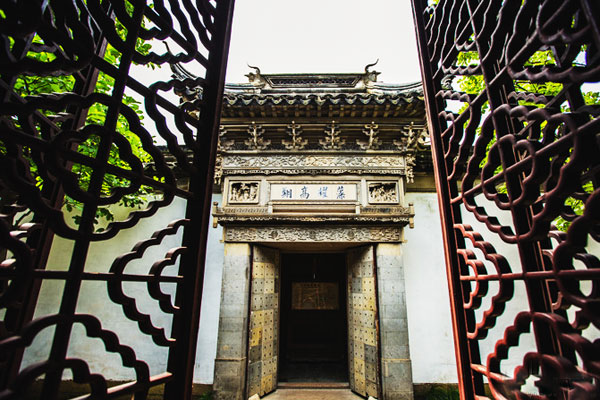 First Glimpse of Gateway with Brick Carvings
First Glimpse of Gateway with Brick Carvings
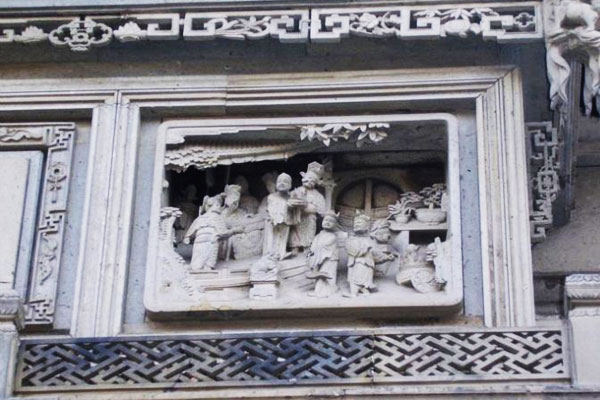 Exquisit Brick Carving
Exquisit Brick Carving
As an independent building in a small courtyard of the northwest corner of Master of the Nets Garden, Peony Study stands out for its primitive and unsophisticated building as well as the romantic feeling it constructs. It is even replicated at the Metropolitan Museum of New York and the Pompidou Center in Paris. The main hall is an excellent place to enjoy the music in that the round ridge roof with smooth line design strengthens the echoes. Looking through the ornamental perforated windows in the north wall, glorious green comes in to your eyes. A banana tree and a group of bamboos look like a three-dimensional picture engraved in the window. The west hall, once the studio of Zhang Daqian, keeps its old furnishing. Seeing the old room and the picture on the wall, we can imagine how Mr. Zhang concentrated on his painting in such an attractive and secluded garden.
In the small courtyard, the rolling rockeries and a chic pavilion make you have much more fun. One high peak perches in the yard against the main hall, like two lovers looking towards each other. In the late spring, the yard is full of bright peonies, attracting many butterflies.
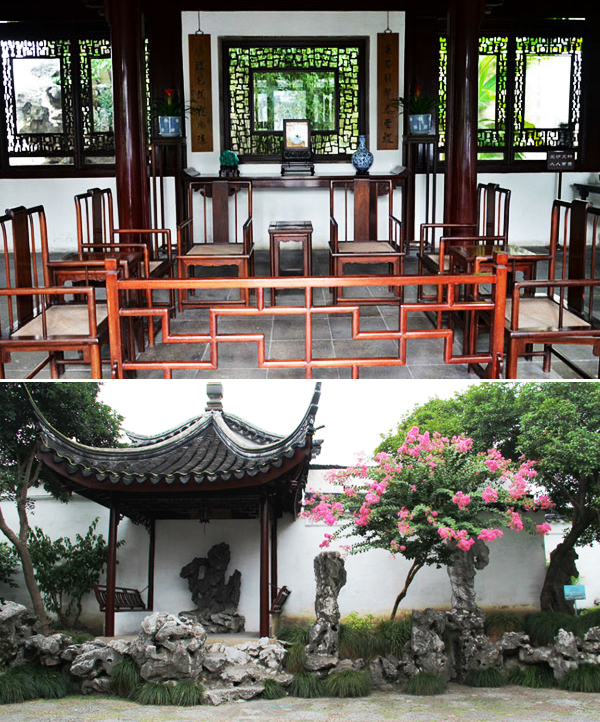 Peony Study and Its Delicate Courtyard
Peony Study and Its Delicate Courtyard
Pavilion for the Advent of the Moon and Wind is situated in the west of the central pond and embracing water on its three sides. This Pavilion acts as a perfect viewing deck. You could feel the cool wind, the bright moon, the colorful lighting and the shimmering water... The highlights of the whole day can be all taken in your eyes while staying in the pavilion. On the wall of the corridor faced with the pavilion is hanging on a mirror. As the moon comes out, it also emerges in the water and the mirror. As you turn around after appreciating the moon in the sky and water, you will be pleasantly surprised by the moon in the mirror. The interaction of virtuality and reality make Master of the Nets Garden so different.
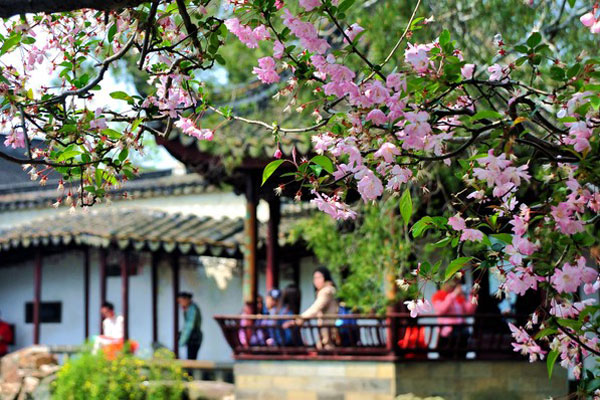 Pavilion for the Advent of the Moon and Wind
Pavilion for the Advent of the Moon and Wind
Yinjing Bridge is a scaled-down arch bridge located in the southeast of the central pond. Less than 3-meter long and 1-meter wide, Yinjing Bridge is referred to as a Three-step Arch Bridge. However, this little bridge is fully equipped with bridge railings, stone steps and bridge opening. There is also a lively embossment of peony in the middle of Yinjing Bridge. Under the bridge is a flowing stream, creating a poetic atmosphere. Standing on the bridge and looking to the north direction, old cypress, tranquil pavilion and sparkling water all leap to your sights. Turning to the south direction, you can have a view of jogged rocks of grotesque shapes and meandering footpath.
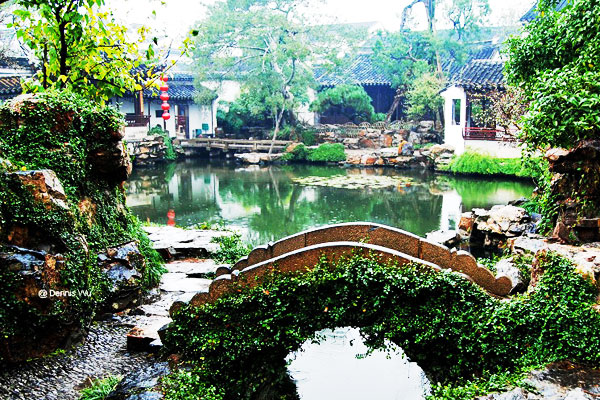 Small but Fully Equiped Yinjing Bridge
Small but Fully Equiped Yinjing Bridge
When the night falls, it turns to a magical concert, fully displaying its local art. Master of the Nets Garden is quite known for its particular Night Garden traditional art performance, a series of musical and acting sketches each set in a different part of the garden, always opening from 7:30 to 21:00 (May to November only). With admission of 100 RMB, two maidservants on ancient costume will lead you to the private garden ablaze with lights. It seems that you open the door of the time and enter the world in hundreds of years ago. You never know what a grand performance is brewed for you until you get to the different halls, including traditional stringed and woodwind instruments performance, classical dance together with a 21-or 25-stringed plucked instrument show, condescendingly melodious Kun Opera, traditional storytelling and ballad singing in Suzhou dialect etc.
From 1990, the classical night garden has been developed to a harmonious combination of classical art and modern life, tangible world heritage and intangible cultural heritage, as well as picturesque garden and euphonic sound. The enchanting Night Garden, like a paradise of lights and sound, will highlight your Suzhou Tour and leave you a lifetime memory.
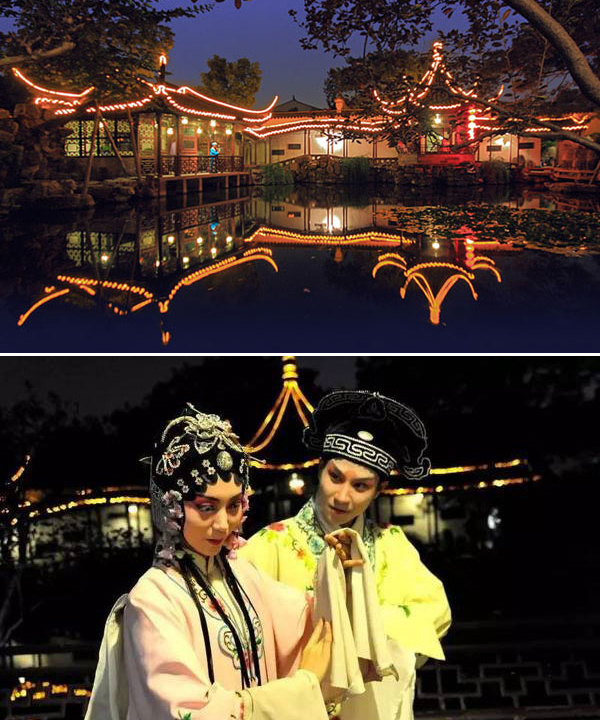 Amazing Night of the Garden and Kunqu Performance
Amazing Night of the Garden and Kunqu Performance
Although Master of the Nets Garden is small, it enjoys many attractions and will satisfy your eyes. Entering the Front Gate and the Chair Hall, you can get to the Wanjuan Hall where 10,000 volumes are collected. The Beauty Within Reach Tower, which said to the living room of the hostess, is your next destination. Then, turn to Five Peaks Library and the Meditation Study. Never miss the Watching Pine and Appreciating Paintings Studio especially in winter, all wood dies except for evergreen pines. After that, have a short rest at Pavilion for the Advent of the Moon and Wind while enjoy the natural landscape. Walking with the pathway, you have Ribbon Washing Pavilion confronted with you. Crossing the exquisite Yinjing Bridge, the amazing Daohe House and Music Room will give you a surprise.
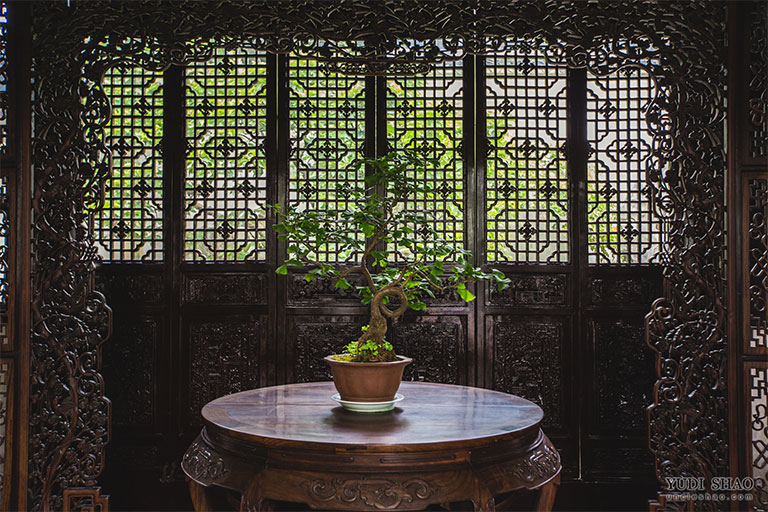 Watching Pine and Appreciating Paintings Studio
Watching Pine and Appreciating Paintings Studio
Canglang Pavilion or Blue Wave Pavilion, listed in the World Cultural Heritages as well and located in the center of lake, is the oldest Suzhou classical garden firstly built in the 11th century. In the center of the garden is a huge rockery and the Canglang Pavilion is hiding at the top of the rockeries. The garden is surrounded by double verandah and several pavilions which connect the inside rockeries and outside waterscape well. The buildings in the garden never fail to attract the attention of tourists. Ancestral Temple of 500 sages is carved with the portraits of more than 500 sages on the walls. Some furniture made from the gnarled roots of banyan trees in the Pure Fragrance House is very impressive. The two-story Mountain-viewing Tower is also interesting. The lower story is piled up by rockeries and equipped with stone table and chairs. Climbing up to the higher tower, you will have a good sight of the amusing path and green bamboo forest.
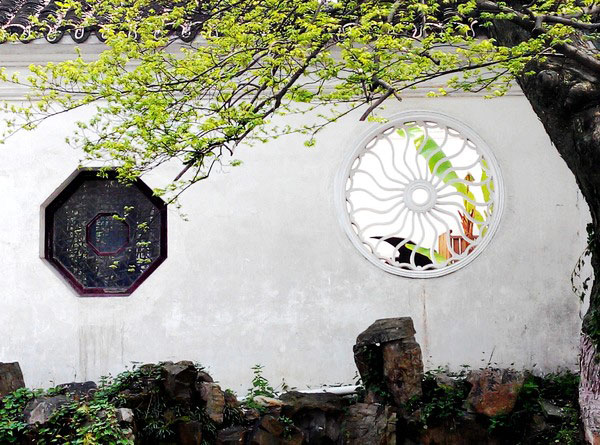 Canglang Pavilion with its Beautiful Windows
Canglang Pavilion with its Beautiful Windows
Located in the Shiquan Street of Suzhou City, you could further your tour by visiting other hot tourists’ spot nearby.
Taking Metro Line 4 to Master of the Nets Garden is also available. While getting off at the Lindunlu Stop, you can catch a bus to Wangshiyuan Stop or walk to Master of the Nets Garden directly (about 10 minutes).
Travelers can take buses No. 202, 811, 55, 811, 936 etc. from different direction to Wangshiyuan Stop. Within 4 minutes’ walk, you are able to get to the amazing Master of the Nets Garden.
If you want to get rid of hustle of public transportation and troublesome navigation, you can book a private tour package which covers sightseeing, dining and transfer from us. Our knowledgeable local tour guide and skilled driver will escort you to Master of the Nets Garden with speed and convenience, and take care of all the details. You just need to focus on sightseeing.
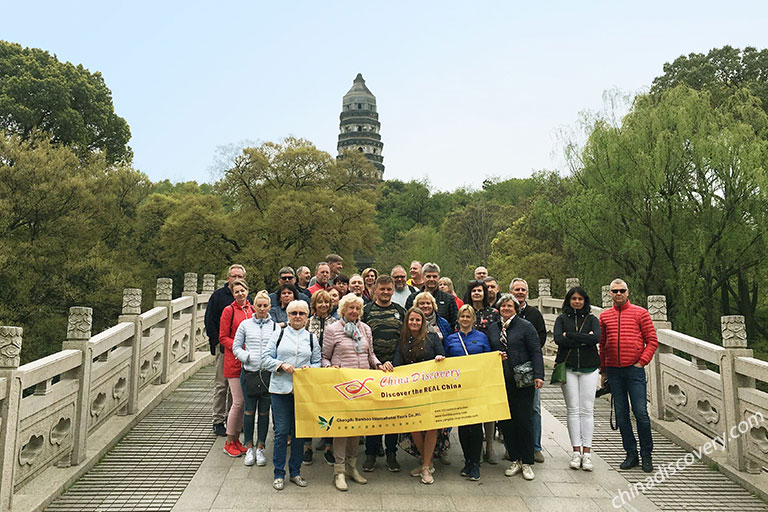 Our Customers in Tiger Hill, Suzhou
Our Customers in Tiger Hill, Suzhou
The inventive design enables Master of the Nets Garden a lovely attraction in all seasons.
In spring, the small garden is full of vigor. Bamboos outside the Prunes Mume Pavilion present emerald green. As the spring ends, the flowers in the courtyard of Peony Study are fully blossomed.
In summer, the lotus is swaying in the wind and the fish is swimming happily in the pond.
In autumn, the Small Hill and Osmanthus Pavilion is a good resort for the fragrance of Osmanthus is really refreshing.
In winter, visit Watching Pine and Appreciating Paintings Studio and enjoy the evergreen pines while other trees are withered.
How to Get to Suzhou: You can easily get to Suzhou by high speed train from Shanghai (about 0.5 hour), Hangzhou (about 1.5 hours), Nanjing (about 1 hour), Beijing (about 4.5 hours), etc.
Best Time to Visit Suzhou: April to October, especially April and May in spring and September and October in autumn
Generally, a classic Suzhou tour takes about 1~2 days. Visiting Suzhou, you can't miss elegant Suzhou gardens, like Humble Administrator's Garden, Lingering Garden, Master of the Nets Garden, etc. You can choose one or two of them for a great garden delight. Other must-be-visited sights in Suzhou City include Suzhou No.1 Silk Factory from which you can watch the process of silk making from silkworms to elegant products, Tiger Hill which is known as the first sight in Suzhou, Suzhou Museum which is designed by I. M. Pei and Suzhou's old canalside roads (like Pingjaing Road and Shantang Street), etc. If you like Jiangnan watertowns, you can visit Tongli, Zhouzhuang or Luzhi to have a wonderful time.
☛ 1 Day Suzhou City Highlights Tour
☛ 1 Day Suzhou Zhouzhuang Tour
☛ 2 Days Best Suzhou & Tongli Water Village Tour
If you want to explore more about Jiangsu Province, you can travel to Nanjing - the old capital city of 6 ancient dynasties, Wuxi - a beautiful lakeshore city, Yangzhou - old culture center of southern China, etc. Check more about Jiangsu Tours>
☛ 5 Days Jiangsu Tour (Suzhou, Wuxi & Nanjing)
In fact, most people travel Suzhou with Shanghai - the best gateway city to Suzhou, and Hangzhou which has long been on a par with Suzhou since ancient times. Generally, it needs 2~3 days enjoying Shanghai's highlights and another 2~3 days appreciating the poetic beauty. Check more about Shanghai Suzhou Hangzhou Tours>
☛ 3 Days Hangzhou & Suzhou Beauty Tour by High Speed Train
☛ 4 Days Shanghai Suzhou Excellent Tour
☛ 5 Days Shanghai Hangzhou Suzhou Highlights Tour
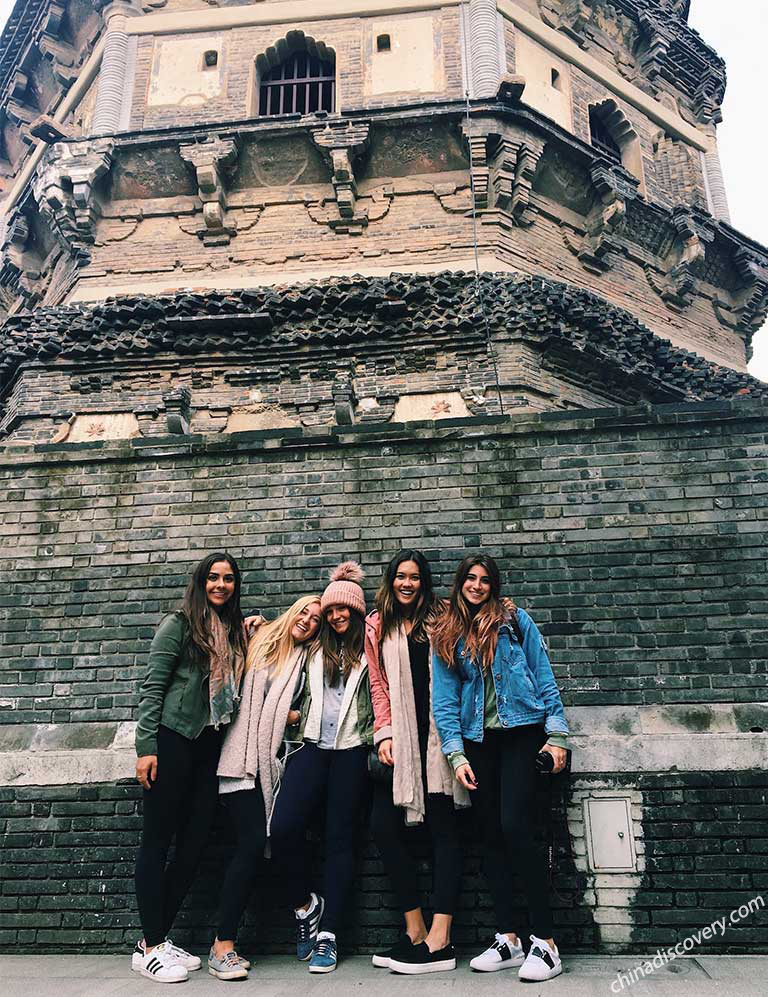 Our Customers visited Tiger Hill, Suzhou
Our Customers visited Tiger Hill, Suzhou
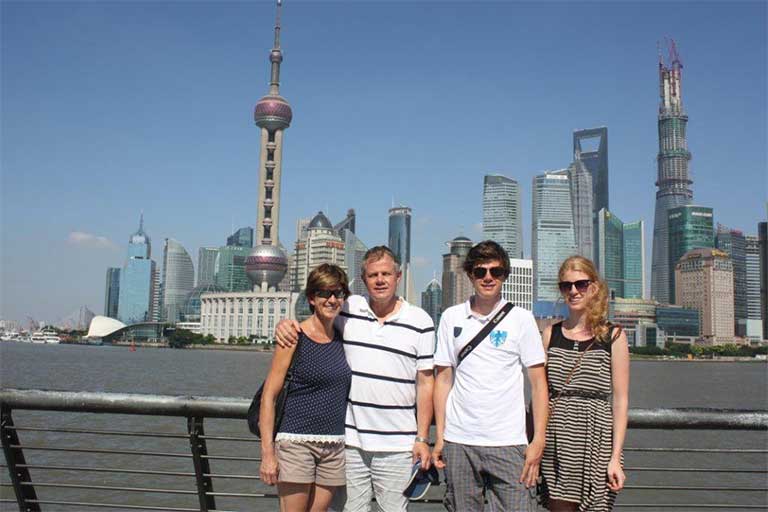 Our Customers visited the Bund, Shanghai
Our Customers visited the Bund, Shanghai
Since 2012, we have helped numerous customers visit Suzhou and surroundings. With our fully-inclusive private tour packages, all of our customers enjoyed their trips to the exquisite gardens, peaceful watertowns, informative silk factory or museum, old Suzhou streets, etc. Some of them kindly shared their precious photos and stories about their Suzhou journey, just get inspired now.
"We were lucky for being able to watch Chinese dancers at the Lingering Garden at the time of visit…" - shared by Nguyen (Check her The Pursuit of Natural Beauty with the Beloved one - 14 Days Beautiful China Exploring Tour>)
"Suzhou was the real treat at the end of the trip! Everything about Suzhou was perfect…" - shared by Elizabeth from Britain (Check her Long-lasting Memory brought by First Trip to China - 16 Days well-Organized and Wonderful First Visit to China>
Besides the wonderful travel stories, many customers who visited Suzhou with China Discovery also send us their first-hand feedbacks about their trip, feel free to read the Suzhou Reviews and learn what they say about their experience. If you want to start your Suzhou tour now, don't hesitate to contact us.
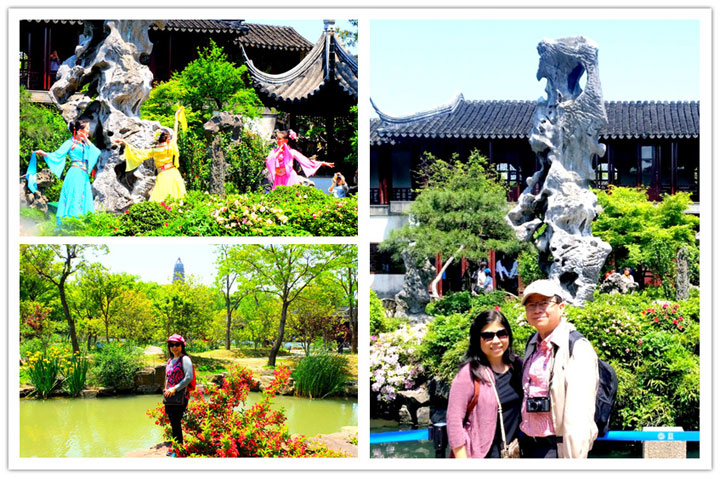 Our Customers Mrs. Nguyen and her husband from Canada visited Suzhou, customized by Wonder Wang
Our Customers Mrs. Nguyen and her husband from Canada visited Suzhou, customized by Wonder Wang
Top 3 Suzhou tours chosen by most customers to explore Suzhou in the best way. Check the detailed itinerary, or tailor your own trip now with us.
Start planning your tailor-made holiday to China by contacting one of our specialists. Once inquired, you’ll get a response within 0.5~23.5 hours.
Customize a Trip